Something's happened to pâté. It must have been declared naff while I was off making the melba toast, because it's dropped off restaurant menus in all but the most firmly traditional of French bistros. As someone brought up on squidgy, warm brussels pâté sandwiches (the potted meat of 1980s home counties life), I've still got a soft spot for the stuff, however — especially the really rich, velvety smooth sort served with an insufficiency of toast and a wispy little salad garnish. Foams and ballotines may impress MasterChef judges, but they'll never hit the spot like a buttery hunk of pâté.
While there's room for a whole larder full of pâtés in my life: chewy rustic pâté de campagne, peppery smoked mackerel, even a nice spicy chickpea number, nothing can hold a candle to a rich poultry liver version for elegance. It's luxurious enough to make the table for your festive feasts (and can be made days in advance) but is easy to throw together for lunch all year round. Did I mention it's dangerously easy too?
The meat
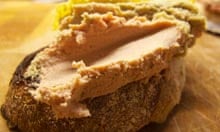
Raymond Blanc is the only chef to soak the livers before use: in the chicken liver parfait recipe in his book Foolproof French Cookery, he immerses them in a mixture of milk and salted water for six hours. This is common practice with pig and ox liver as it softens the slightly bitter, metallic flavour, but I think it's counterproductive to subject milder flavoured poultry offal to this treatment: it robs his pâté of character.
Like Constance Spry, who is responsible for the second baked pâté recipe I try, he adds the livers to his pâté raw. Paul Merrony, chef of the tiny Giaconda Dining Room, has contributed a recipe for a smooth duck liver pâté to Simon Hopkinson and Lindsey Bareham's retro cookery book, the Prawn Cocktail Years, which looks promising enough for me to adapt for chicken. It involves poaching the livers before pureeing, as does a Jewish-style chicken liver pâté I find in Saveur magazine, albeit in stock rather than salted water.
All four seem to lack the savoury meatiness of the other recipes I try, which saute the livers in hot butter first. The initial browning process seems to be as important here as it would be in a stew or roast — it adds a depth of flavour. If they're diced, I don't think you need to fry them for five minutes as Delia suggests, though: they should still be slightly pink in the middle.
Spry combines the liver with chopped bacon, which, although it's a tried and tested flavour combination, doesn't work in a pâté: the bacon just takes over. Perhaps it would be better with a more strongly flavoured liver: she doesn't specify any particular variety in her recipe.
The fat
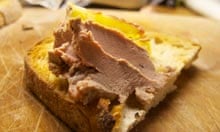
Although I'm tempted to try Alain Chapel's warm chicken liver parfait recipe as given in Michel Roux Jr's A Life in the Kitchen, I decide reluctantly that a dish served warm and turned out onto a plate garnished with a crayfish claw isn't strictly in the spirit of what I'm trying to create. It's a shame, because I'm intrigued by the idea of a pâté made with bone marrow — I'd be interested to know if anyone has tried it.
More conventional recipes tend to use butter (Delia Smith), butter and cream (Merrony and Julia Child), or butter and eggs (Blanc). Saveur, in a nod to the laws of kosher, suggests chicken fat as an alternative to butter and minces in hard-boiled eggs as a thickener.
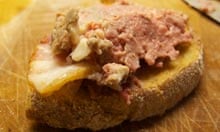
My pâté tasting panel complain that Delia's chicken liver pâté is "a bit oily", although it's set solid: the winner, texture-wise is Merrony's pâté, which is smooth and creamy, denser than Child and Blanc's moussier efforts, the latter of which is apparently "a bit like eating a meaty Walnut Whip". I think this must be due to the higher proportion of cream and butter. The Saveur pâté, meanwhile, is downright heavy, with a slight chalkiness which I don't like.
Spry goes down a completely different route, folding her minced liver and bacon into a bechamel sauce. This gives it a weirdly sloppy texture which doesn't go down well at all: in fact, it's likened to "a brain on a plate".
The flavourings
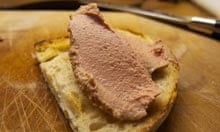
Although I'm keen to retain the flavour of the livers themselves, a little seasoning will make things a lot more interesting. Booze and pâté is a time-honoured combination, and Blanc really goes to town, using madeira, port and cognac in his recipe. Delia and Saveur thriftily suggest simple brandy, Merrony goes for port, and Child gives the option of madeira or cognac. I really like the subtle sweetness of madeira with the chicken: port seems a bit of a blunderbuss, and I can't pick up much of the cognac apart from the alcohol in Delia's recipe. Everyone else reduces theirs before use, which concentrates the flavour.
Spry doesn't use alcohol, but she makes up for it with garlic and anchovies — there's "far too much going on" in her pâté, as Gregg Wallace might say, and the livers themselves are almost an afterthought. Delia and Blanc also use garlic, but I'm just not keen on it here: it's too harsh. Child goes for spring onions, and Saveur onion, but I'm sticking with Blanc's shallot, for its slightly vinous sweetness.
Thyme is a classic partner with chicken, used by everyone except Merrony, and I'm not going to argue: it's a brilliant combination. Instead, Merrony seasons the pâté with quatre-epices, a mixture of ginger, cloves, nutmeg and white peppercorns which I think is too strong for the chicken, although I suspect it might work better with the duck livers he actually uses in his recipe.
The sweet pepperiness of Child's allspice is a more harmonious addition, and I'm going to slip in a bit of ginger too, just because it's nearly Christmas. Delia's ground mace also works well as an alternative, but I'm not at all sure about the mustard powder: it sticks out like a sore thumb.
The cooking

Everyone but Delia and Saveur recommends pushing the mixture through a sieve before chilling, which I can't endorse heartily enough: there are always little bits left after pureeing, and pâtés should either be coarse or smooth, not gritty.
Blanc and Spry bake theirs in a water bath and a cool oven. This gives them a firmer, lighter, less creamy texture — they look more impressive, particularly Spry's, encased as it is in streaky bacon, but I prefer the richness of the set variety.
Lastly, if you're eating the pâté almost immediately, there's no real need to cover it in a seal of melted butter — Child doesn't bother — but it looks pretty, and saves real gluttons the embarrassment of asking for the butter dish. All this actually needs, however, is some thin, crisp toast, and perhaps a green salad as a salve to your conscience.
Perfect chicken liver pâté

Serves 4
350g chicken livers, cleaned
175g butter, diced
1 shallot, finely chopped
1 tsp thyme leaves, finely chopped
75ml madeira
75ml double cream
½ tsp salt
1 allspice berry, ground
¼ tsp ground ginger
1. Cut the livers into roughly 1.5cm pieces, and heat a knob of butter in a frying pan over a medium heat. Add the shallot and thyme and soften, then turn up the heat to medium-high, add the livers and saute for a couple of minutes until browned on the outside but still pink inside. Tip into a food processor.
2. Add the madeira to the pan and boil until reduced to a couple of tablespoons. Tip into the food processor, add the cream, salt and spices and whizz until smooth. Add all but 75g of the butter, and whizz again. Taste for seasoning and adjust if necessary.
3. Pass through a sieve into a serving dish and chill for half an hour. Melt the remaining butter and pour on top, then refrigerate until set.
Why has pâté gone out of fashion in this age of recession? Which are your favourite varieties, from fish paste to sobrasada, and is there any better accompaniment than half a loaf of toasted bread, and a cold, rainy day?
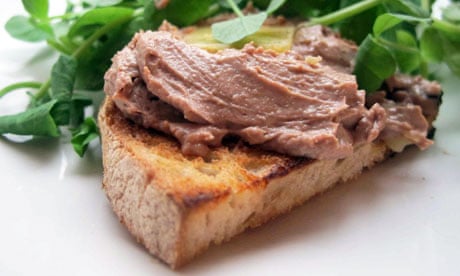
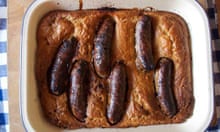
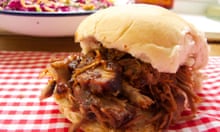
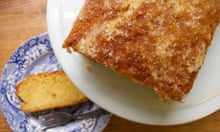
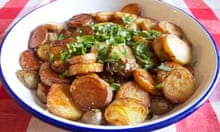
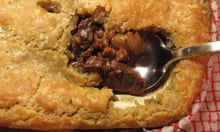
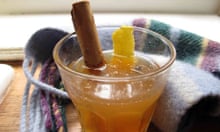

Comments (…)
Sign in or create your Guardian account to join the discussion